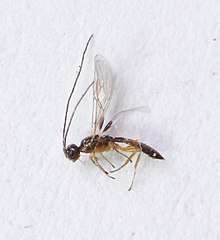Doryctinae
The Doryctinae or doryctine wasps are a large subfamily of braconid parasitic wasps (Braconidae). Numerous genera and species formerly unknown to science are being described every year. This subfamily is presumably part of a clade containing otherwise any or all of the Alysiinae, Braconinae, Gnamptodontinae, Opiinae and Ypsistocerinae, and might be most closely related to the last one of these. Whether the Rogadinae are also part of this group is not known.
| Doryctinae | |
|---|---|
.jpg) | |
| Female doryctine ovipositing on beetle larvae inside wood | |
| Scientific classification | |
| Kingdom: | |
| Phylum: | |
| Class: | |
| Order: | |
| Suborder: | |
| Family: | |
| Subfamily: | Doryctinae |
| Genera | |
|
Numerous (almost 180), see text | |
Description and distribution
Doryctine wasps are found across almost the entire size range of Braconidae, from 1 to 25 mm. In the small species the head tends to be relatively large and the body, while slender, remarkably elongated. Doryctines tend to be small-winged, with many having very much reduced wings. Numerous species in this family are unable to fly or even lack wings entirely. They have a characteristic row of stout spines running lengthwise along the foreleg tibia, and a cyclostome depression above the mandibles.[1]
Doryctinae have a worldwide distribution (except the polar regions).[1]
Biology
Some Doryctinae are known to form galls on plants similar to the Mesostoinae (a small subfamily endemic to Australia).[2] Some species in the genus Allorhogas feed on seeds.[3] The large majority of doryctines are idobiont ectoparasitoids of the larvae of wood-boring beetles – such as jewel beetles (Buprestidae). Some species parasitize lepidopteran or symphytan larvae. The host is paralyzed by venom injected through the female's ovipositor before an egg is laid.[3] The spines present on the foreleg of the adult enable it to escape from the narrow wooden tunnels of the hosts.
Biological control
Doryctines have been used to control pests in Europe, Australia, and North America. Several doryctine wasps are of economic importance as biocontrol agents in Australia against eucalyptus pests.[1] The species Spathius agrili has been introduced to the United States from China in an effort to control the Emerald ash borer.[4]

Selected genera
Genera placed in the Doryctinae include:
|
|
References
- Stevens et al. (2008)
- Samacá-Sáenz, Ernesto; Meza-Lázaro, Rubi N.; Branstetter, Michael G.; Zaldívar-Riverón, Alejandro (2019-11-17). "Phylogenomics and mitochondrial genome evolution of the gall-associated doryctine wasp genera (Hymenoptera: Braconidae)". Systematics and Biodiversity. 17 (8): 731–744. doi:10.1080/14772000.2019.1685608. ISSN 1477-2000.
- Wharton, Robert A.; Marsh, Paul M.; Sharkey, Michael J. (1997). Manual of the New World Genera of the Family Braconidae (Hymenoptera) (PDF). Washington DC: The International Society of Hymenopterists. p. 69.
- Gould, Juli; Bauer, Leah, "Biological Control of Emerald Ash Borer (Agrilus planipennis)" (PDF), Animal and Plant Health Inspection Service (APHIS), United States Department of Agriculture, retrieved 28 April 2011